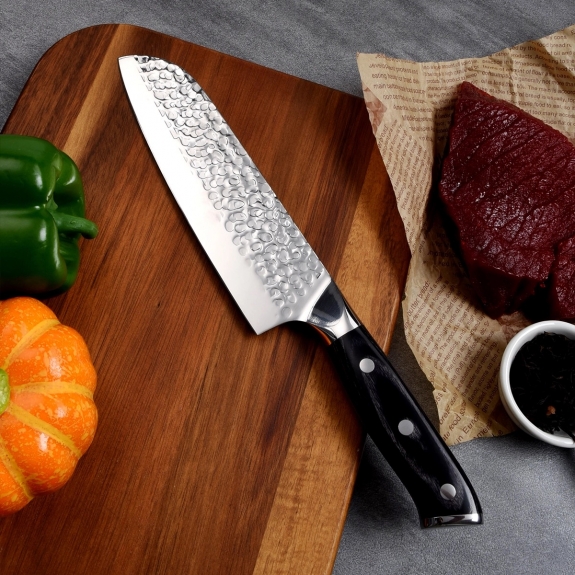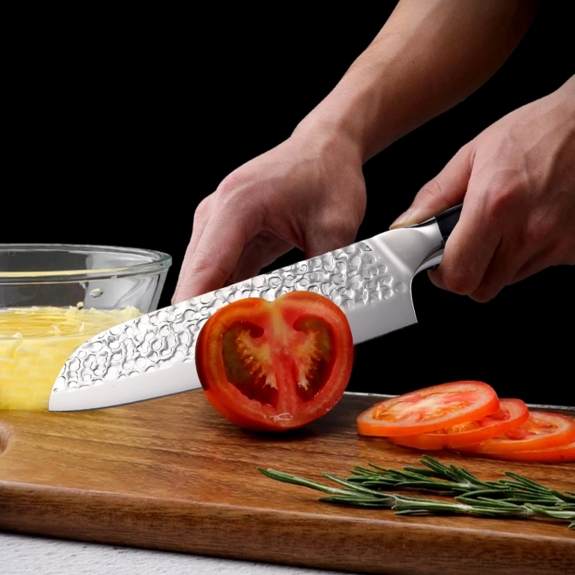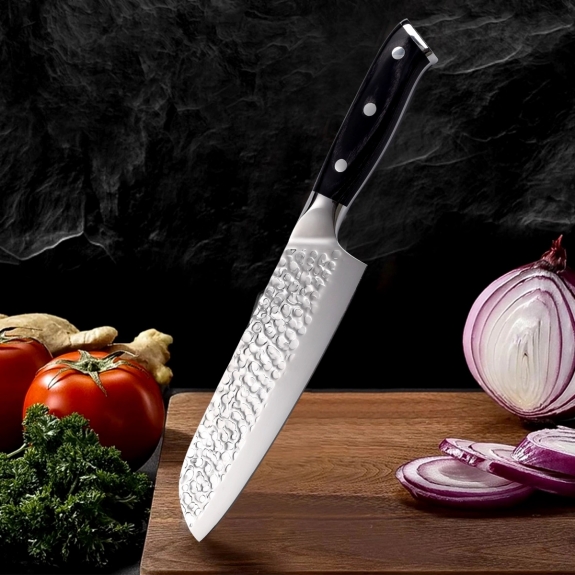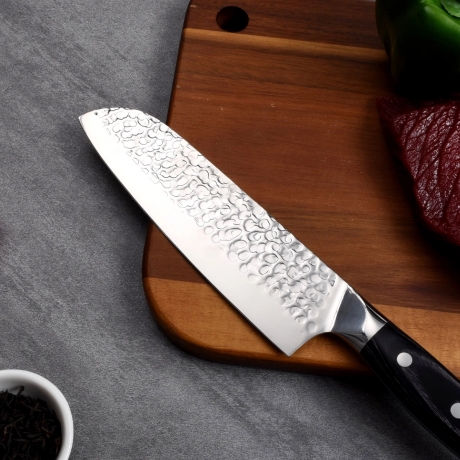The Santoku knife, a staple in many kitchens, is renowned for its versatility and unique design. Originating from Japan, this knife has gained popularity worldwide, often being compared to the traditional Western chef's knife. In this article, we will explore the distinct features of the Santoku knife, its uses, and why it might be the perfect addition to your kitchen arsenal.
Understanding the Santoku Knife
The Origin of the Santoku Knife
The term "Santoku" translates to "three virtues" in Japanese, which refers to the knife's ability to excel in three primary tasks: slicing, dicing, and mincing. This knife was developed in Japan during the mid-20th century as a response to the changing culinary landscape, where home cooks began to seek tools that could handle a variety of tasks efficiently. The Santoku knife reflects the Japanese philosophy of simplicity and functionality, making it a favorite among those who appreciate both form and function in their kitchen tools. Its design is a testament to the evolution of culinary practices, adapting to modern cooking needs while retaining traditional craftsmanship.
Design Features of the Santoku Knife
The Santoku knife typically features a shorter blade, usually ranging from 5 to 7 inches in length. Its blade is wider than that of a traditional chef's knife, which allows for a more stable cutting surface. The edge of the Santoku knife is often flat with a slight curve, making it ideal for a straight chopping motion rather than the rocking motion used with chef's knives. This design not only enhances precision but also reduces the risk of accidents, as the user can maintain better control over the knife. The balance between the blade and the handle is meticulously crafted, ensuring that the knife feels comfortable and secure in hand, which is essential for prolonged use in the kitchen.
Blade Shape and Edge
One of the most notable characteristics of the Santoku knife is its blade shape. The blade is generally thinner and lighter than that of a chef's knife, which enhances maneuverability. Many Santoku knives also feature granton edges—dimples along the blade that help reduce friction and prevent food from sticking, making it easier to slice through ingredients. This feature is particularly beneficial when working with sticky foods like potatoes or cheese, as it allows for smoother cuts and less mess. The sharpness of the blade is crucial, as it determines how effortlessly the knife can glide through various ingredients, making meal preparation quicker and more enjoyable.
Handle Design
The handle of a Santoku knife is designed for comfort and control. It is often made from materials such as wood, plastic, or composite materials, providing a secure grip. The ergonomic design of the handle ensures that it fits comfortably in the hand, reducing fatigue during extended use. Additionally, the handle's shape allows for a variety of grips, accommodating different cutting techniques and preferences. A well-designed handle not only enhances the user experience but also contributes to the overall safety of the knife, as a secure grip minimizes the chances of slipping while cutting.

Comparing the Santoku Knife to Other Knives
Santoku vs. Chef's Knife
While both the Santoku and chef's knives are versatile kitchen tools, they serve slightly different purposes. The chef's knife typically has a longer blade, which is better suited for rocking motions, making it ideal for tasks like chopping herbs or mincing garlic. In contrast, the Santoku knife excels in precision tasks, such as slicing vegetables or fish. The choice between these two knives often comes down to personal preference and cooking style. For those who frequently prepare intricate dishes or work with a variety of ingredients, the Santoku knife may offer the versatility needed to tackle diverse culinary challenges.
Santoku vs. Paring Knife
The paring knife is a smaller knife designed for intricate tasks like peeling and trimming. While the Santoku knife can handle these tasks, it is not as precise as a paring knife. However, the Santoku's versatility allows it to perform a broader range of functions, making it a more practical choice for many home cooks. The paring knife excels in detail work, but for those who prefer a single knife that can handle both detailed and general tasks, the Santoku knife is an excellent option. This adaptability makes it a valuable tool for both novice cooks and experienced chefs alike.
The Versatility of the Santoku Knife
Ideal for Various Ingredients
The Santoku knife is particularly effective for slicing vegetables, fruits, and proteins. Its design allows for clean cuts, which is essential for presentation in dishes. The wide blade also makes it easy to transfer chopped ingredients from the cutting board to the cooking pot. This efficiency is especially appreciated in fast-paced cooking environments, where time is of the essence. The ability to handle a variety of ingredients with ease means that the Santoku knife can be the go-to tool for everything from preparing salads to filleting fish, making it an indispensable part of any kitchen.
Perfect for Different Cooking Styles
Whether you are preparing a stir-fry, salad, or a delicate fish dish, the Santoku knife can adapt to various cooking styles. Its ability to perform multiple tasks makes it a favorite among both professional chefs and home cooks. The knife's versatility is further enhanced by its suitability for different cuisines, from Japanese to Italian, allowing cooks to explore a wide range of culinary traditions. This adaptability not only simplifies meal preparation but also encourages creativity in the kitchen, as cooks can experiment with different techniques and ingredients without needing to switch tools constantly.
Maintenance and Care for Your Santoku Knife
Proper Cleaning Techniques
To maintain the integrity of your Santoku knife, it is essential to clean it properly after each use. Hand washing with mild soap and warm water is recommended. Avoid using abrasive sponges that can scratch the blade. After washing, dry the knife immediately to prevent rusting, especially if it is made from high-carbon steel. Proper care extends the life of the knife and ensures that it remains a reliable tool in your kitchen. Additionally, storing the knife in a protective sheath or on a magnetic strip can help prevent damage to the blade and keep it sharp for longer.

Sharpening Your Santoku Knife
Keeping your Santoku knife sharp is crucial for optimal performance. Regular honing with a honing steel can help maintain the edge. For more significant sharpening, using a whetstone or professional sharpening service is advisable. A well-maintained edge not only enhances cutting efficiency but also ensures safety while using the knife. Understanding the sharpening process and knowing when to sharpen your knife can significantly impact your cooking experience. A sharp knife requires less force to cut through ingredients, reducing the risk of slips and accidents, making it a safer option for cooks of all skill levels.
Conclusion
The Santoku knife is a remarkable tool that combines functionality with elegance. Its unique design and versatility make it an essential addition to any kitchen. Whether you are a seasoned chef or a home cook, understanding the features and benefits of the Santoku knife can enhance your culinary experience. By investing in a quality Santoku knife and taking proper care of it, you can enjoy its benefits for years to come. Embracing this tool not only elevates your cooking skills but also brings a touch of Japanese culinary tradition into your home, enriching your overall cooking journey.

Frequently Asked Questions regarding Santoku Knife
1. What types of food can I use a Santoku knife for?
A Santoku knife is versatile and can be used for slicing, dicing, and mincing a variety of foods, including vegetables, fruits, meats, and fish. Its design allows for clean cuts, making it ideal for both raw and cooked ingredients.
2. How do I choose the right Santoku knife?
When choosing a Santoku knife, consider the blade length, weight, and handle material. A blade length of 5 to 7 inches is common, and the knife should feel balanced and comfortable in your hand. Look for high-quality materials, such as high-carbon stainless steel for durability and sharpness.
3. Can I use a Santoku knife for tasks typically done with a chef's knife?
Yes, a Santoku knife can perform many tasks typically done with a chef's knife, such as chopping herbs, mincing garlic, and slicing meats. However, its design is more suited for straight chopping motions rather than the rocking motion used with chef's knives.
4. How often should I sharpen my Santoku knife?
The frequency of sharpening depends on how often you use the knife and the types of food you cut. Regular honing after each use can help maintain the edge, while more significant sharpening with a whetstone or professional service may be needed every few months or when you notice a decline in cutting performance.
5. Is a Santoku knife suitable for beginners?
Yes, a Santoku knife is an excellent choice for beginners due to its versatility and ease of use. Its design allows for precise cuts with less effort, making it a user-friendly option for those new to cooking. Additionally, its ability to handle various tasks means that beginners can rely on it for a wide range of culinary activities.






